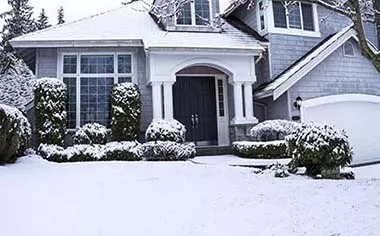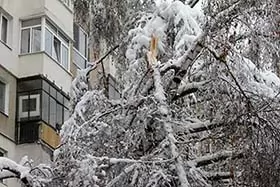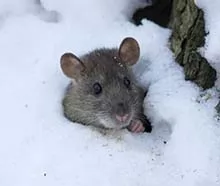We all love a white snow blanket. Snow looks pretty in your landscape. But today, we’ll talk about the good things and bad things about snow in your landscape.
During January 2018, the Storm Grayson hit the East Coast of the United States, and it covered Virginia and many states with snow. After Storm Grayson ended, it has snowed a couple of times in Virginia. Now let’s see what snow brings.
The Good Things about Snow in Your Landscape
Perfect Insulator

Snow is beneficial to the plants in your landscape. How so? Well, it’s quite simple. Snow acts as an excellent insulator. In other words, snow protects your plants from freezing.
How is that possible? Well, snowflakes are composed of 90% of air trapped in ice crystals. An interesting fact is that a blanket of snow can keep the ground temperature close to 32 degrees when the air temperature is below zero.
Without a white snow blanket, cold temperatures can freeze the ground, causing significant damage to the root system of shrubs and trees.
Moisture from Melting Snow
Once back in spring, moisture from melting snow will water your plants’ roots, helping them to grow healthy again. However, excessive snow can produce flooding in the landscape; thus, you must be aware of that once spring hits back.
Fertilizer
Snowflakes are carries of nitrogen and sulfur. Thus, when the snow melts, these elements get into the soil, which of course are absorbed by plants later on. So, indeed, snow is an excellent fertilizer.
What are the Cons of Snow in Your Landscape?

Snow Weight
Snow can add load stress to your trees and bushes. For instance, when there is a storm, the wind and the weight of snow can split or break weak branches.
To avoid damage to your branches, you must shake the excess of snow gently.
Shelter for Rodents

Having snow in your landscape is good. But excess is always bad. When there is a thick layer of snow, this becomes the perfect place to refuge rodents. Voles, mice, and other small animals can tunnel under the snow, making trails in the lawn, chewing on the bark of shrubs and young trees.
You can stop this by keeping your lawn short and clearing snow away from the base of trees.
Excess of Salt
When melting the snow away from sidewalks, walkways, and driveways, you most likely will use salt. The danger is that salt can get into the soil in vast quantities, which can dry out your plants. So, you should avoid using excessive ice melting products, salt, etc.
Another great advice is to avoid walking on snow-covered grass since doing so will damage the lawn. Make sure that sidewalks, driveways, and walkways are free of ice and snow, so people use them instead of crossing your yard.
That’s pretty much for today. We hope that this info was helpful to you. We advise you to keep in touch so that you can learn a great deal about landscaping care.
We all love a white snow blanket during the winter season. Snow looks pretty in your landscape and in a way, it creates a festive feeling during the end of the year. But today, we’ll talk about the good things and bad things about snow in your landscape. Though it looks good, it has its cons.
During January 2018, the Storm Grayson hit the East Coast of the United States, and it covered Virginia and many states with snow. After Storm Grayson ended, it has snowed a couple of times in Virginia. Now let’s see what a snowy winter season can mean for your landscape.
The Good Things about Snow in Your Landscape
Perfect Insulator
To start, snow is beneficial to the plants in your landscape. How so? Well, it’s quite simple. Snow acts as an excellent insulator. In other words, snow protects your plants from freezing.
How is that possible? Well, snowflakes are composed of 90% of air trapped in ice crystals. An interesting fact is that a blanket of snow can keep the ground temperature close to 32 degrees when the air temperature is below zero.
Moreover, snow slows down the escape of heat stored in different surfaces. The characteristics mentioned prior influence the rate of heat moving from the ground and into the atmosphere. One of its greatest capacities it o indeed serve as an insulator.
Without a white snow blanket, cold temperatures can freeze the ground, causing significant damage to the root system of shrubs and trees. The fluffier the coat of snow, the better it will actually be.
Moisture from Melting Snow
Moreover, once spring is back into the picture, moisture from melting snow will water your plants’ roots, helping them to grow healthy again. In fact, farmers count up to 50% of moisture from snow-melt to enter their soil.
However, excessive snow can produce flooding in the landscape; thus, you must be aware of that once spring hits back.
Fertilizer
On a similar not, snowflakes are carries of nitrogen and sulfur. Thus, when the snow melts, these elements get into the soil, which of course are absorbed by plants later on. So, indeed, snow is an excellent fertilizer. As you may already know, fertilizer provides nutrients and enriches your lawn.
What are the Cons of Snow in Your Landscape?
Heavy snowfall breaks a tree branch
Snow Weight
In addition, snow can add load stress to your trees and bushes. For instance, when there is a storm, the wind and the weight of snow can split or break weak branches.
Now, to avoid damage to your branches, you must shake the excess of snow gently.
Shelter for Rodents
Here’s the thing; a thick layer of snow is perfect for sheltering rodents of all sizes.
Having snow in your landscape is good. But excess is always bad as it is for any other thing. When there is a thick layer of snow, this becomes the perfect place to refuge rodents. The rodents that excess snow can shelter include:
- Voles
- Mice
- And other small animals can tunnel under the snow.
The little critters are known for making trails in the lawn, chewing on the bark of shrubs and young trees.
You can stop this by keeping your lawn short and clearing snow away from the base of trees.
Excess of Salt
When melting the snow away from sidewalks, walkways, and driveways, you most likely will use salt. The danger is that salt can get into the soil in vast quantities, which can dry out your plants. So, you should avoid using excessive ice melting products, salt, etc.
Another great advice is to avoid walking on snow-covered grass since doing so will damage the lawn. Make sure that sidewalks, driveways, and walkways are free of ice and snow, so people use them instead of crossing your yard.
Now that you know the pros and cons of snow on your landscape we advise you to take the appropriate measure. To ensure that your landscape is getting the proper maintenance and care, you can always count on a professional from Mi Jalisco Landscaping.
That’s pretty much for today. We hope that this info was helpful to you. We advise you to keep in touch so that you can learn a great deal about landscaping care. Mi Jalisco is always at your service!



